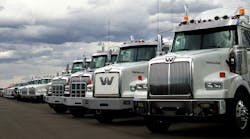A couple of large buyouts have permanently changed the landscape of the truck tire industry during the past few months. Bridgestone goes from sixth place to first place in the retread market through its purchase of Bandag, with approximately 44% of production. Goodyear remains in second place, with 27.5% of the market, and Michelin remains in third place, although the acquisition of Oliver increases its market share from to 21% from 13%.
This means that about 92.5% of the retreads in North America are under the control of the Big Three truck tire makers, who with all their affiliated brands already have approximately 72.5% of the new truck-tire market locked in.
Acquisitions like these happen only once in a lifetime in the tire business; any more buyouts will not have this kind of significance unless the Big Three become the Big Two. The question on the minds of most fleet executives is, how will these changes affect operations?
The answer to that depends on whether you take the glass-half-full or glass-half-empty view of the situation. The half-full camp will probably point to the advantages of having another cradle-to-grave supplier of tires and retreads. This should help fleets lower costs, since all three companies are now on a seemingly level playing field. Prior to the Bandag purchase, Bridgestone was unable to provide an integrated new truck tire and retread program for major fleets, so Michelin and Goodyear had a definite edge. Now that all three are forced to compete on equal footing, it should result in more bargaining power for fleets.
But the half-empty folks are focused more on the lack of choices, particularly on the retread side of the equation. And no matter which group you fall into, 92.5% of anything in the hands of three companies is a little scary. The naysayer will immediately point to fewer options as a negative for fleets, simply because most of the retread production is now controlled by the Big Three.
Bridgestone and Michelin have publicly stated that they are going to allow Bandag and Oliver to function separately, so there shouldn't be any major changes for the end user in the near future. But as the companies begin to integrate operations, it's logical to assume that there will be some consolidation and shifts in the product mix. Niche markets may be the first to feel the effects, with higher prices or elimination of particular tread designs as each manufacturer evaluates the profitability of producing specialty products.
On the bright side, the hundreds of Bandag and Oliver retreaders are still independent businesses that can eventually switch to another tread rubber manufacturer if they aren't pleased with the end result of the acquisitions. Even though 7.5% of the market may not seem like much, it's still in the neighborhood of 1.2-million retreads, so there should be more than enough production should anyone want to make a switch.
These acquisitions should not have much of a near-term impact on fleets serviced by large commercial truck tire dealers. But fleets using smaller dealers could witness their vendors going out of business, as the investment required to stay with a Big Three retread program may make it difficult for some of them to remain profitable. After all the dust has settled, some could find themselves looking for new retreaders.


